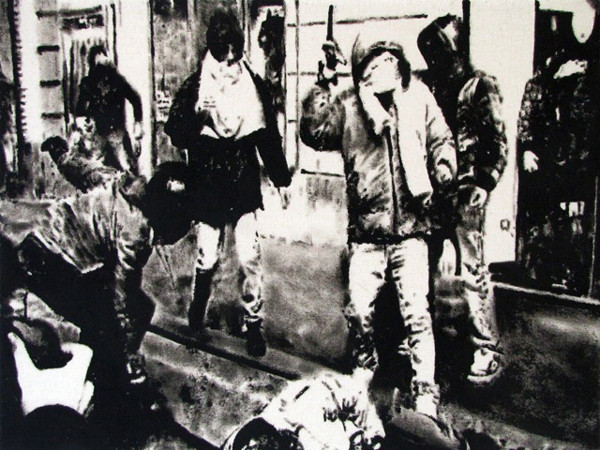When Poets Die
10 Feb - 02 Apr 2011
WHEN POETS DIE
Florian Heinke, Julia Oschatz, Stefan Pfeiffer & Anika Rosenberg
10 February - 2 April 2011
The work of Florian Heinke (b. 1981), mostly oversized painting, usually combines text and image. Through black colour, the painter captures themes of humanity such as love, passion and death. Invented by Heinke, his style "Black Pop" combines bold messages with general statements and image elements of his personal youth culture. The artist appears again and again as protagonist in his art: sometimes the image of the artist, whose body is also covered with tattooed lettering, sometimes as a logo, a brand and a signature.
The artist Julia Oschatz (b. 1970) deals with the issues of "landscape" and "identity" in paintings held in dark colours, drawings and video installations. Julia Oschatz plays on different levels with the projection of human feelings in nature. A creature with animal head and human body appears in various natural scenes. These projections feed romantic and tragic stereotypes. The artist moves thus close to the border areas of the imaginary, the fantastic and the expansive reality. The canvas and screen serve as interfaces to allow the appearance of projections of beings spread in imaginary spaces. Julia Oschatz 's fictional characters move through imaginary and familiar worlds, natural landscapes and drawing spaces, through forced claustrophobic worlds and idyllic scenery.
In the collages by Stefan Pfeiffer (b. 1981) the human body is often exposed to strange scenarios. The artist manipulates cut outs of photos and newspaper articles, painting them over, robbing them of their original background, placed in a new context that corresponds to his logic. In the predominantly non-representational paintings, the artist creates his own worlds where things are combined together and not to be found elsewhere. "An important aspect of the way I work is that I am interested in the veracity of information found only on a personal level. It is the claim that the line between fantasy and fact, which drives me and amuses me, can be a vacuum free of misconceptions, from which a new reality can arise. "(Stefan Pfeiffer, 2010)
The artist Anika Rosenberg (b. 1981) presents herself as each of the figures involved in the story, as a spy, a successful inventor, as a cosmonaut and as a contract killer. For her complex exhibition concept which works with the media, photography, drawing, text and video, borrowing from major themes of the science fiction genre, in which real opportunities are enriched with fictional speculation. For her repertoire of motifs, the artist uses various historical events, fictional templates and the contemporary discourse on art theory together with ideas, motifs and materials.
(Text: Claudia Olbrych)
Florian Heinke, Julia Oschatz, Stefan Pfeiffer & Anika Rosenberg
10 February - 2 April 2011
The work of Florian Heinke (b. 1981), mostly oversized painting, usually combines text and image. Through black colour, the painter captures themes of humanity such as love, passion and death. Invented by Heinke, his style "Black Pop" combines bold messages with general statements and image elements of his personal youth culture. The artist appears again and again as protagonist in his art: sometimes the image of the artist, whose body is also covered with tattooed lettering, sometimes as a logo, a brand and a signature.
The artist Julia Oschatz (b. 1970) deals with the issues of "landscape" and "identity" in paintings held in dark colours, drawings and video installations. Julia Oschatz plays on different levels with the projection of human feelings in nature. A creature with animal head and human body appears in various natural scenes. These projections feed romantic and tragic stereotypes. The artist moves thus close to the border areas of the imaginary, the fantastic and the expansive reality. The canvas and screen serve as interfaces to allow the appearance of projections of beings spread in imaginary spaces. Julia Oschatz 's fictional characters move through imaginary and familiar worlds, natural landscapes and drawing spaces, through forced claustrophobic worlds and idyllic scenery.
In the collages by Stefan Pfeiffer (b. 1981) the human body is often exposed to strange scenarios. The artist manipulates cut outs of photos and newspaper articles, painting them over, robbing them of their original background, placed in a new context that corresponds to his logic. In the predominantly non-representational paintings, the artist creates his own worlds where things are combined together and not to be found elsewhere. "An important aspect of the way I work is that I am interested in the veracity of information found only on a personal level. It is the claim that the line between fantasy and fact, which drives me and amuses me, can be a vacuum free of misconceptions, from which a new reality can arise. "(Stefan Pfeiffer, 2010)
The artist Anika Rosenberg (b. 1981) presents herself as each of the figures involved in the story, as a spy, a successful inventor, as a cosmonaut and as a contract killer. For her complex exhibition concept which works with the media, photography, drawing, text and video, borrowing from major themes of the science fiction genre, in which real opportunities are enriched with fictional speculation. For her repertoire of motifs, the artist uses various historical events, fictional templates and the contemporary discourse on art theory together with ideas, motifs and materials.
(Text: Claudia Olbrych)

